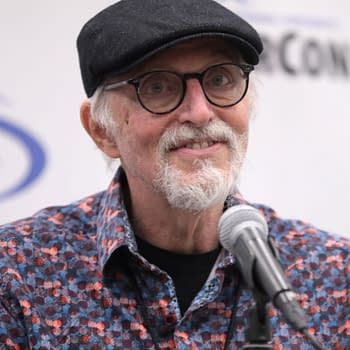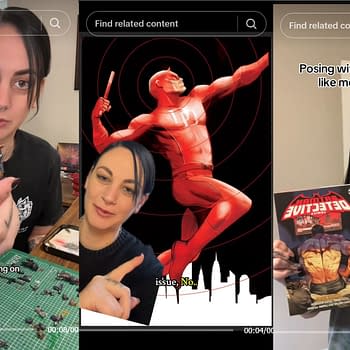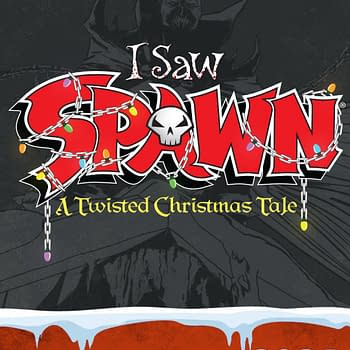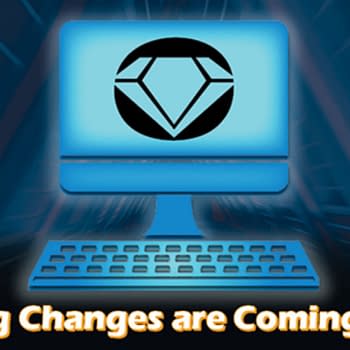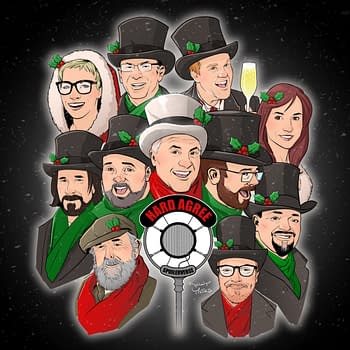Posted in: Comics | Tagged: dc, kevin smith, phil hester, swamp thing
A Career Retrospective With Phil Hester
Travis Ellisor writes;
I first encountered Phil Hester's work when he teamed-up with Mark Millar (and a bit of Grant Morrison) on one of the best Swamp Thing runs ever. My opinion of his art improved greatly once I started seeing his collaborations with inker Ande Parks, and then I found that Phil was a great writer as well as artist! Phil has written and/or drawn some of the best and yet most underrated comics in the past twenty-five years (seriously, anyone who wants to write or drawn comics should go out and study his The Wretch). Phil was nice enough to talk to Bleeding Cool about his career so far.
Let's start off with the question I ask everyone I interview: how did you get into comics?
I loved both drawing and reading as a kid, so comics seemed like a very natural way to tell stories to me. I was a casual reader of comics until about age 11 when that tsunami of adventure pop culture sort of swept the country. Between Star Wars, The Hulk TV show, and Marvel, Charlton and DC Comics exploding from every drug store shelf, super heroes really dug themselves into my imagination. I had maybe a stack of 60 or so comics I had owned from age 8-10, but that summer I had my own lawn-mowing money and started to take up the hobby pretty heavily. I bought issue 118 of Iron Man, which ends with a great cliffhanger of Tony Stark being thrown off of the SHIELD Helicarrier without his armor and having to scramble to get it on before he hits the ground. Breathtaking! I simply could not wait for the conclusion to come out a month later, so I folded up some of my Dad's computer print-out paper and sketched my own conclusion to the cliffhanger. Up to that point, I was vaguely aware that human beings drew the comics I liked, and started to really pay attention to the credits and follow the guys I really enjoyed. That cliffhanger exercise made it finally sink in that, "Hey, I like to draw . . . and these guys draw for a living . . . maybe I could be one of them!"
Even at a young age I was drawn to the off-kilter comics. Although I enjoyed Spider-Man and Batman, like every other comics fan, I found a kind of tingly, illicit thrill in the weirder books like Swamp Thing, Tomb of Dracula, and Werewolf by Night. Even bright comics, as long as they were outside of the norm, fulfilled that appetite for weirdness, so things like E-Man and Micronauts were just treasures to me.
I wish you had that Iron Man conclusion you drew to show us. I bet it was awesome. I started off reading Transformers and X-Men comics but I slowly discovered the weirder characters and now I love them. I remember reading a reprint of an old Legion of Superheroes comic which featured the Legion of Substitute Heroes and wondering why I couldn't buy a comic featuring THOSE guys. I mean, Stone Boy should be as popular as Batman, right?
Anyway, what all kind of art training and education did you receive?
Like most teenaged comic book artists, I thought Marvel would hire me right out of high school, so I started bombarding them with photocopied samples at about age 16. Back then editors were kind enough to write back to delusional young artists with occasional pointers. While working to incorporate those notes, I also enrolled in a traditional art school, not necessarily to become a better cartoonist, but a better artist. I graduated from the University of Iowa with a BFA in drawing, and minors in sculpture and painting. Although this training didn't inform my cartooning directly, it did make me a much better artist, especially the continuous life drawing. I walked into art school counting Frank Frazetta as my favorite painter and I walked out with Mark Rothko. It really prepared me to absorb the work of artists like Dave McKean, Bill Sienkiewicz and Gary Panter.
That said, I started working in comics during the summer between my sophomore and junior years. I was getting spot illos into Amazing Heroes. I think I was so excited that I actually saved that first check for $4.95 from Fantagraphics. I wound up penciling for those black and white explosion pop-up publishers who were so desperate for talent that they took chances on a really horrible, naive artist from the Midwest.
Okay, so before we get too deep into your work in comics, tell me about your short career in animation. How did you get into that and which series did you work on?
I did animation storyboards for only a year or so between my runs on Swamp Thing and Green Arrow. I had unwisely passed on some start-up Vertigo books, and found myself out of work. I guess I was lucky in that the existing crop of storyboard artists working at the time were raised on humor stuff; they all wanted to be Chuck Jones (of course). Stuff like Batman: The Animated Series and Superman were taking off and there was a need for adventure-minded artists. Warner Bros. actually ran an ad in the CBG searching for comic book artists who wanted to try their hand at animation boards. I sent in an issue of The Wretch and was given a shot on Batman, a show I was already deeply in love with. Butch Lukic tried his best to make me a boarder, and my buddy Mike Manley was also a great help. I actually got to do a few scenes on both Batman and Superman, but I lived in Iowa and working long distance wasn't optimal for WB.
Thankfully, that little bit of experience on such a great show opened doors for me to board other action shows of the time. I boarded Big Guy and Rusty the Boy Robot (damn that character design, Geoff Darrow!), and Men In Black. It was fun, but trying to stay on model to someone else's style was very difficult for me. I had been used to calling my own shots in comics for too long. I was ready to get back to funnybooks.
Well, that's a cool little side trip you took in your career. And you did get to work on some of the best animated series of that era.
Yeah. I got spoiled. After Batman, every other show is downhill!
Okay, the first time I remember seeing your art was in the Swamp Thing run you did with Mark Millar. But while looking through your bibliography I saw that you worked on two Swamp Thing short stories before that run, in the Vertigo Jam special and Swamp Thing Annual #7. So how did you get that gig and how excited were you to be drawing one of your favorite characters?
I owe my run on Swamp Thing entirely to Stuart Moore and Neal Pozner. Neal was the new talent scout at the time and had been looking for little gigs for me here and there. He got me a test on Swamp Thing with Stuart, who was editing the book. Stuart liked my stuff, but I don't think he was blown away. Somewhere in here I also did a Black Orchid short for Vertigo– or soon to be Vertigo– which brought me to Stuart's attention. Anyway, I really, really wanted Swamp Thing. It was one of my favorite books as a kid. I have the Wein & Wrightson/Redondo run memorized, and I loved the Moore/Bissette/Totleben/Veitch era, of course.
So, I knocked myself out on the samples, but they didn't quite click with Stuart. He gave me a soft pass. I know this will sound hokey, but I had just seen the great Albert Brooks movie Defending Your Life in which characters have to defend all their life choices in an afterlife court of judgment. The movie really hammered home how destructive regrets can be, and it inspired me to call Stuart back and plead my case. I volunteered to do another round of samples to land the book. Thankfully, I think the artist they had decided on had become unavailable, so DC settled on me. Kismet! I was deeply thrilled for every second I had on the book, even if my work was never really up to snuff. In a way, it's like being married to someone completely out of your league (which I am); you love the experience even though you probably don't deserve it.
While working on Swamp Thing, you had a short story published in Negative Burn #23 which debuted one of my favorite concepts: The Wretch. How did you come up with that character and his weird home Glass City?
Well, I lived there. I still do. I grew up and live in a very, very small rural town. The kind of place you can hear the corn grow at night in the summer. Isolated, quiet, Ray Bradbury-ville. The people are all sweet and kind, but there's a kind of perfect stillness that settles over a little town at night that is almost impenetrably creepy. I always thought little towns deserved super heroes, too, but an extra-creepy little town should get an extra-creepy hero. My concept of Glass City was as sort of the nexus of all good old American weirdness; Bigfoot, UFOs, ghosts, hook-handed killers, urban legends of all kinds. The hometown hero had to be equally weird to handle all this mess.
To be honest, The Wretch exists mostly as a storytelling exercise. He has no character, no dialogue, and no backstory. His powers change from tale to tale. We don't even know if he's a he, or even a human being. He just pops up, deals with the badness in an innovative, but satisfying way, then disappears. He's 100% deus ex machina, and since that's a given up front, it liberates you to tell whatever kind of stories you want and simply have him walk through when you need him. It's hard to explain, but it almost becomes a formalist exercise in storytelling. Of course, the other players have human predicaments and emotions that engage the reader, but The Wretch himself is this kind of unsearchable force of nature. Explaining it is hopeless. You have to read it, I think. It's Something Wicked This Way Comes, but with Boo Radley playing the creepy, mute Spider-Man from Electric Company skittering around in the corner of your field of vision.
Anyway, it got me the only sniff I've had at an Eisner to date.
Well, The Wretch is still my favorite comic from you, and I'm hoping we'll get to see more Wretch stories in the future.
There is more Wretch coming someday. I have a flat file with a dedicated slot for each active project, and The Wretch drawer is open and full.
Now another very significant thing about the Wretch stories is that they were first comics wherein I saw your art inked by Ande Parks, who went on to have very long art collaboration with you. How did you meet Ande and what has your experience working with him been like?
I met Ande at one of the early Planet Comicons in Kansas City. I was working on Fringe with Paul Tobin and Jim Woodyard at Caliber and we went down to KC with a huge, hand-made booth. This must have been '89 or '90? Anyway, it was way back when I actually had time to get away from the table and cruise the other artists. Ande's style really spoke to me and it seemed like we were at similar stages in our development. Ande had a modern look to his stuff, but used plenty of old school brush, pen and texture techniques that spoke to the EC fan in me. Almost immediately, we agreed to work together and did a few covers for Kirk Chritton's awesome Comics Career Newsletter. We did a Robotman cover and a Judah the Hammer piece. Good luck finding them!
Our relationship grew into not only a fruitful professional collaboration, but a great friendship. We have grown at a similar pace as both artists and writers, sharing ideas, techniques, and connections. I honestly think of his inks as what my inks would look like if I had the facility to handle a brush or pen with the kind of assuredness Ande does. We went through a long period between our early collaborations like Rust or Freaks Amour and connecting again on Green Arrow, but we were always looking to collaborate like star crossed lovers torn apart by the vagaries of comic book publishing. I can say, without a doubt, that our working relationship is the most important connection I've made in my time in comics. Ande has moved away from inking and into writing full time, but our time collaborating — Green Arrow, Ant-Man, Nightwing, The Wretch — produced some of the most satisfying work of my career.
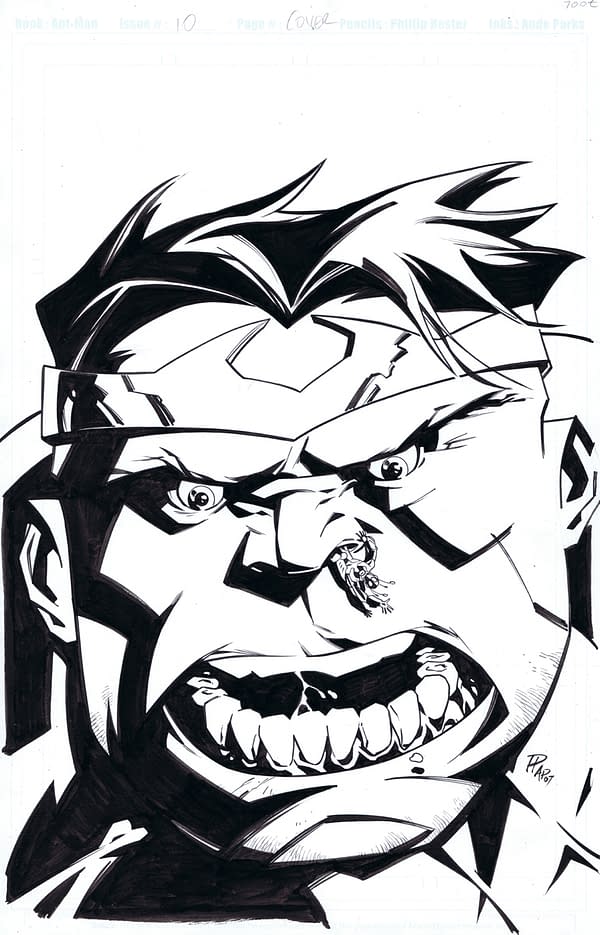
I think I'm okay to ink myself on something like Boneshaker (collected in the Oversight short story collection), but not something that requires a deft, assured hand like Green Arrow or Ant-Man.
And while we're talking about your early collaborations with Ande, how did the two of you get involved in Freaks' Amour? And were you a fan of Tom De Haven's work before working on the book?
I hadn't read the novel yet, but after getting the assignment I did and loved it, becoming a huge fan of Tom. Dana Andra's adaptation is super faithful, almost scene-for-scene, so anyone who has read the comic gets the gist of the book (I hope). Bob Schreck had been championing my work for a while and I recall he had a hand in getting me put on the book, although the actual editor was Jerry Prosser. The book can get very dark and sometimes explicitly brutal, so I really cut loose with the high contrast, grimy, built-for-black-and-white drawing and Ande followed suit with a whole suite of gritty textures and dirty, slashing lines. I was heavily under the influence of Jose Muñoz at the time and this story seemed the perfect place to display that new voice.
The book marks an important step in both our careers in that, up to that point, I still thought I was going to be Steve Rude someday. I mean, I was already doing alternative-style work at Caliber and Taboo, but as I said earlier, I saw that as sort of a side thing. I was also getting work at DC drawing stuff like the Flash, and at Marvel on Namor, with a style that was very mainstream super hero. I imagined I would keep honing that traditional, illustrative style until I was Alan Davis, or at least a feeble imitation. Freaks' Amour came along and, by the demand of the subject matter, forced me to merge my disparate styles into the goofy hybrid of cartoony and creepy it remains today.
I'm still fairly proud of the work and glad Dark Horse has chosen to collect it recently. I hope Ande feels the same way. I think we didn't get in the way of the adaptation, at least.
Moving on, in 1999 you drew Clerks:The Lost Scene, written by Kevin Smith. How did you hook up with Kevin?
I think Kevin asked for me on Clerks because he had been a Swamp Thing fan. I think he actually used to own a page of original art from my run, a Batman vs Swampy shot. Anyway, we had a mutual pal in Bob Schreck, who was still at Oni, or just leaving at the time, so when the idea of more View Askewniverse comics came up, Bob connected us. Originally I was slated to draw Mallrats 2, which was an unproduced screenplay at the time – I think. I did some test drawings of the usual suspects and Kevin seemed to dig them, but some problem cropped up with the script, so they shifted Ande and me on to Clerks: The Lost Scene. I think Kevin enjoyed working with us, which led into our getting the Green Arrow gig.
I was a huge Kevin Smith fan at the time so I remember him talking time about doing a Mallrats comic, and wondered what had happened to it. Well, shortly after this you produced The Coffin with Mike Huddleston. I think that was the first book of yours that I had read where you only wrote the story and did not do the art. How did it come about and what was it like working with Mike?
We go back once again to the fabled Planet Comicons of yore in Kansas City. I bumped into Mike in artists' alley and was floored by his work. I met him and Jim Mahfood at earlier KC shows when they were kids (real kids) and was impressed by their work. I followed their careers as they wound up drawing a book I had once drawn called Rust with creator Steve Miller, but really took note of Mike upon seeing his new black and white painterly style at that Planet Comicon. I had been kicking around the idea for The Coffin since high school and had always intended to draw it myself, but after seeing Mike so masterfully combine his breathtaking painting skills with a rock solid understanding of composition and a great sensibility for science fiction, I knew he'd draw it better than I ever could. Mike surpassed anything I could have hoped for. He's really an awe-inspiring talent and a great guy. I count myself lucky to have ever worked with him, and I hope or next collaboration is sooner than later.
Shortly after The Coffin's debut, you once again collaborated with Kevin Smith and Ande Parks on a relaunch of Green Arrow. You ended up staying on that book for years, working with both Brad Meltzer and Judd Winick after Smith left the book. How was that whole experience?
I have to say I was spoiled by the whole thing. There was a span of my career where I was drawing for Mark Millar, Grant Morrison, Brian Bendis, Kevin, then Brad and Judd. It was a pretty sweet run! It was a fantastic time. My style is not exactly mainstream super hero, so getting to handle DC's #1 book (at the time) was an unexpected treat. The royalties were– and still are– pretty nice. People buy those first 4 or 5 Green Arrow trades at a nice clip even today. It was also at a time when my wife and I had two little ones at home, so producing a successful book was very helpful.
Of course, I think I had very little to do with the popularity. That's not false modesty. Those writers bring in crowds wherever they go. I was just trying to keep up. Still, I got to draw a lot of characters I've loved since childhood, and sort of became the Green Arrow guy for a new generation of comic book readers. Sorry, you guys! You got robbed; when I was a kid it was Neal Adams.
All that said, I think I learned an awful lot about making comics by running on that monthly treadmill for four or so years. At least I was a better artist when I left than when I started. It wasn't until I left, and the subsequent protestations I heard from both DC and fans, that I realized I wasn't totally useless. I was afraid I was wearing out my welcome by the time I left, but maybe I was just finally wearing all the readers down.
Also, I learned a lot about writing from seeing all those talented folks do their thing.
I should point out right now that you are way too modest!
In 2006, Image released Oversight: Collected Short Stories 1990-2005, a collection of your short stories. Was this your idea? Because I loved it, especially since it collected some stories that are nearly impossible to find.
I think Oversight was Joe Pruett's idea. The book came out from Image, but was produced during the Image/Desperado partnership of the time. When Joe and I looked back on all the work I had done for Negative Burn (which Joe had edited), including the shorts I did for Taboo, Deadline USA and other places, we realized there was enough there for a collection. A lot of the stories were produced for an aborted book called Sponge that Paul Tobin and I were set to do for Caliber after Fringe. Despite the age of much of the work represented, I'm still keen on most of the material. I think I mentioned in the introduction that I thought all my experimental short story work was a lark, and my super hero stuff was my mainstay. But looking back on it, the weird stuff holds up much better. It features a lot of experimental technique like xerography and collage, so is not as dependent on my wobbly drawing. I guess that's what saves it.
Making short stories like those is probably what I miss the most about the 90s. There were a lot of anthologies running at the time, so if I ever got a wild idea for a story I'd just do it and worry about placing it later. I never considered whether it was even good or bad, or if it made sense; I just expressed myself. Some are not even proper stories, just little obtuse, indulgent tone poems. I was and am a big fan of Laurie Anderson, and these little stories were my attempt at the sort of irreverent musical or spoken work bits she'd do that could start out looney or weird, but take a sudden turn toward something deeper. I hope to get back to that kind of storytelling soon.
Another book that you put out at Image around this time was Firebreather, with Andy Kuhn on art. I think you already know that I am a HUGE Firebreather fan, and yet I've never asked you or Andy how you guys came together and created this book. So tell me now!
We'll have to go back to '98 or so. At the time Marvel was actively trying to develop new talent on fresh takes of existing characters in what was to become a new Epic line. I think the whole thing went belly up before anything could come of it, but it inspired Andy and I to pitch a book called The Crew, which was basically Young Avengers before Young Avengers. It featured young versions of Captain America, Scarlet Witch, The Thing, Wolverine and She-Hulk breaking away from the AIM labs that created them. They eventually fell under the mentorship of Hawkeye and became junior Avengers. Chris Claremont, who was in a creative decision-making role at Marvel at the time, really dug it and asked us to add what turned out to be a great element, which was young villains for the heroes to fight. So, we cooked up a young Dr. Doom clone called Mars, and a son of Fin Fang Foom called Foom.
For one reason or another, the whole thing stalled and Mr. Claremont left his position, but Andy and I couldn't give up on the idea. We really loved the idea of a teenaged Ben Grimm trying to fit in at a high school with his rocky orange skin as much as we loved the conceit of an ersatz Godzilla having a human son he wanted to rule his domain someday. We mashed those two concepts together, along with a healthy dose of old school Peter Parker, into Firebreather. Luckily, around 2003, Image was starting up a shared super hero universe and we took Firebreather there. The rest is history. I hear one of the other super hero books launched was called Invincible or something.
I should make it crystal clear that I don't think Marvel cribbed their eventual Young Avengers book from our pitch in any way. Ideas rise and fall in the roiling foam of comics like that.
I now want to see what these Avengers kids looked like and will be bugging Andy to find out if he still has any unused designs. Anyway, while we're talking about the Firebreather comic, let's talk about the movie. What can you tell us about that whole experience?
The Firebreather movie experience was all very surreal from start to finish. Fun, but surreal. I think after the first issue of the first mini shipped, we were contacted by a producer named Adrian Loudermilk who got the book optioned by Paramount for a feature film, Sadly, Adrian passed away soon after. The project stalled, but when it reverted back to us, Julia Pistor, who had seen Firebreather bumping around at Paramount, thought she could get it made as an animated feature. She had produced Nacho Libre and A Series of Unfortunate Events, so this was the first time a film person who had, you know, actually made films was interested in our book.
She got things set up at Cartoon Network where the project went through several different incarnations. At one point it was a 2-D animation, then live action (with a human Duncan!), then 2-D again, then a game show (not really), then CGI. Thankfully, the project survived all the transformations and network comings-and-goings to actually go into production. When Andy and I heard Peter Chung was slated to direct we were ecstatic. We were both big fans of Peter's from Aeon Flux and his other groundbreaking animation work. Through the whole process we sort of averted our eyes to the ups and downs of production. It can be a soul-crushing experience to watch your idea get adulterated in any way, and since our deal didn't give us any real power, we took a very hands-off approach. We got paid by the nice people at Cartoon Network, so we let them do their thing and chimed in when they asked us for specific advice. But once Peter got involved, a lot of our worries just fell away. We knew, at the very least, the movie would be visually stunning. We also knew Jim Krieg, the screenwriter, was a comics nerd like us (He writes for the current Green Lantern show on CN), so we didn't worry about keeping the spirit of the book alive.
All that said, it was very, very strange to see our idea handled by so many different people. The day we saw footage screened at San Diego was sort of the peak of the surreality of it all. Gregg Goldin, one of the producers from Cartoon Network, showed us a rough cut in our hotel room. Right beforehand we were sweating, thinking, "what if this sucks?" Thankfully for all involved, it turned out to be very cool, even in the rough cut stage. We weren't going to have to lie about the movie at the Comicon panel!
Cartoon Network had set up a little signing for us in the autograph area and we were all head-down, sketching and signing so busily we didn't even notice Peter Chung patiently waiting in line to talk with us. He was such a polite guy he would never interrupt to say, "Hi. I directed your movie." Anyway, he is a super-talented dude and I think the stuff he did was just amazing. Of course, I'll always prefer the comic, but it was awesome to see our characters on TV.
I'll admit that I wanted the movie to be in traditional 2-D animation, and was apprehensive about the CGI until I saw the whole film. But it turned out to be quite excellent! Still, if they ever do an animated series for The Wretch, I think it better be in 2-D.
Agreed on the Wretch flick. Also, it should be in B&W.
Moving right along, you reteamed With Mike Huddleston for one of your more trippy stories with Deep Sleeper. For those not familiar with that book, tell them all about it.
After Mike and I did The Coffin, we immediately started work on our next book, which was called Deep Sleeper. The book was about a frustrated family man who was kind of failing at fatherhood when he found he could lucidly project his awareness into the astral plane. What's more, he found that the things he thought were mere dreams could cross over into our physical plane, and that he was capable of controlling these manifestations. This made him a target for all sorts of nefarious creeps, especially those disembodied souls who hijack bodies when astral projectors are "away." Cole loses his family to one such "vacant" and has to fully assume his power in order to not only get them back, but rescue the rest of humanity from a similar fate. It was a family drama, a confessional epistle, science fiction, history, horror, romance, philosophy– all at the same time. The product of reading too many Jim Starlin comics as a kid.
I think it's probably the best reviewed thing I ever wrote. Mike took his work to a new level, combining his earlier, well-established gift for realism and painterly technique with very modern graphic approaches and daring cartooning. All the art is twice up to give him extra room to stretch all his newly developed muscles.
Although nearly everyone loves The Coffin more, Mike and I consider Deep Sleeper the superior work. It started at Oni, but a dispute over film rights led to its cancellation. We took it to Image who completed the series. Recently, IDW put out a gorgeous hardcover version that I recommend to anyone who digs Mike's or my work. It doesn't embarrass me even 10 years later, so it's got that going for it. It also features a villain called The Dervish, who may be the best bad guy I ever created.
In 2006 you teamed up with Robert Kirkman for a new ongoing series at Marvel, The Irredeemable Ant-Man. I loved this book. The lead character, Eric O'Grady, was such a jerk that I have no idea why I ever rooted for him in his conflicts. I also loved that costume design. Tell us about that whole experience.
It was all Kirkman's idea! Every few years Robert will call me and say, "Why are you wasting your time on that? Come do this!" Ant-Man was my first and only regular gig at Marvel, which is funny since I was always a Marvel kid, but wound up doing the majority of my pro penciling work at DC. I think Robert really wanted to examine what it would be like for all the trappings of heroism to be dropped into the lap of someone who was definitely not heroic on any level. People always say Peter Parker is an everyman, but he's not. Peter is a heroic personality with a nerdish exterior. Eric is completely average throughout. Peter Parker is the guy we think we are. Eric O'Grady is the guy we are when we skip showering because it's Saturday.
Robert sort of eased me into the gig by having me do some Marvel Team-Up covers, which were great fun, especially designing Iron Maniac. When it came time for the actual book, I wanted a design that looked insect-like, alien, and as unheroic as possible. I wanted him to look like something you could see skittering around and want to squash it. We designed the armor, the retractable legs, the mandible mask, etc., months ahead of publication. The vagaries of comics publishing meant that the Iron Spider version of Spider-Man dropped a few months before Ant-Man, sharing a similar extra set of cyborg legs. In the end, the design was an homage to Micronauts with the big Acroyear boots and Bug's antennae and eye goggles.
We had a lot of fun on the project. If you recall, we worked on a sixteen panel grid– Robert's idea– meaning we could fit as many as sixteen panels on a page, though we rarely went that far. Robert wanted to get as much story as possible out in a short amount of time, sort of a tonic against the decompressed storytelling that still rules comics. We told a LOT of story in the first six issues, but the tiny panels were killing me. Luckily, Cory Walker could step in and show me up for a few months until my eyes and wrist recovered. I loved the book, and am proud that Eric wound up becoming a mainstay of the Marvel U, even though the costume didn't. I don't think more literal-minded, realistic artists could commit to the amount of cartooning that's involved in the original armor.
People still love the book to this day, which makes me ask, "Where were you when we got cancelled?"
Well, I bought every single issue, so it's obviously somebody else's fault that it got cancelled.
Near the end of your Ant-Man run you co-wrote a comic with Chuck Satterlee called Thirteen Steps, which featured art by the ever-so-talented Mr. Kevin Mellon. Tell us the origin of this project and how was it working with Chuck and Kevin?
Like almost everything I do, 13 Steps had been germinating for some time. The book was done specifically for Joe Pruett's Desperado Studios while he was partnered up with Image. I was way overbooked at the time, but Joe was eager to get the project rolling, so I looked for some help. I plotted each issue Marvel style, Chuck wrote a "shooting script," and I went back over the dialogue before we handed it off to Kevin for him to spin it into gold. We also would tag team certain scenes, with each of us flying solo for specific scenes. I remember writing the roller skating scenes myself, and Chuck writing the hunting scene. Chuck got the last laugh, because when the book was optioned and we read the eventual pilot teleplay, his hunting scene was included more or less verbatim while my romantic roller-romance didn't make the cut.
I knew both Chuck and Kevin from the Midwestern comics scene. I'd been eager to work with Kevin for a long time, ever since I read his and Dennis Hopeless's Gearhead. He was pretty young then, and had a ton of upside, so I didn't want to wait for someone else to swoop in and nab him.
The whole conceit of the book is An American Werewolf in America With a Crap Job and an Overbearing Mom. Justin, our hero and werewolf, is very conflicted about eating people, so he seeks out what amounts to AA for monsters. He sits in on a meeting of ghouls, succubi, goblins, zombies, etc. and winds up with a vampire sponsor who tries to steer him toward responsible predation. Along the way he discovers identity politics is not limited to humans, and that his curse can actually become a gift if channeled constructively. As I mentioned before, it was optioned by Sony TV, but petered out after shows like Being Human and True Blood beat us to the punch for supernatural dramedies.
Well, I think that television swooped in and got Kevin, since he's working on the Archer TV series now, but hopefully he'll keep drawing comics as well.
Also around this time you started a long run writing The Darkness at Top Cow. I'll admit that I had never read the book before you began writing it, but I thoroughly enjoyed it. How did you get involved in the world of Jackie Estacado?
You can blame Rob Levin for that. He was the newly minted Editor in Chief at Top Cow at the time they were looking for a reboot of the franchise. He convinced Marc Silvestri, Filip Sablik and Matt Hawkins to have a semi-open casting call for a new writer. I sort of went overboard with my pitch and sent them what amounted to my three year plan for the character. I think I was in a good place in that I liked the character, but was not slavishly devoted to his adventures. For one thing, Jackie Estacado came along well into my adulthood, so I could never develop that smothering crush I have for things like Spider-Man or Swamp Thing that fell upon me in childhood. That allowed me to be a little more objective about the core of the concept and cut out what wasn't working. Maybe that's why they settled on me.
Luckily, I got paired with the brilliant Michael Broussard on the early issues and we managed to do some memorable, unusual Darkness tales. I got to work with a bunch of fantastic artists along the way, especially in the 75th anniversary jam. The book, undeniably, is a showcase for artists. Being an artist myself, I think the smartest thing I did with The Darkness was give Michael, Jorge Lucas, Sheldon Mitchell, Whilce Portacio, and all the other artists fun things to draw and get out of the way.
Maybe we managed to drag in some readers like you who would never give The Darkness a second look, which I think was Rob's goal. I just tried to write smart scripts that looked good when drawn. I think we managed to do that and have a lot of fun along the way.
During your run on the Darkness, you kept writing and drawing plenty of other comics. One of the stranger ones was Golly!, with Brook Turner on art. Themes dealing with Heaven and Hell show up in a lot of your work, but rarely being dealt with by a tobacco-chewing carny. Explain yourself, Phil.
What's to explain? Again, Golly had been lurking in my sketchbooks for about a decade 
The carnival depicted in Golly is an amalgam of all the de-romanticized traveling carnivals of my youth. In the Midwest, little busted out promotions will tour all summer, descending on a different small town each weekend to fleece the yokels and steal a few heads of livestock for a cookout. As I said before, I love that Bradbury-style carnival, but the everyday banality of these modern, meth-fueled sideshows had a distinct charm I wanted to get across. Golly is a figure eight race car driver and maintenance man for one of these shabby carnivals when he is approached by an angel who informs him that Armageddon has been cancelled for lack of interest on the part of the Almighty. However, some factions of Hell haven't got the memo, so Golly has been chosen to root out the last vestiges of evil still bent on starting something on judgment day. Golly, despite his self-proclaimed ignorance, is good at heart, and tries his hardest to live up to the challenge. The book featured Golly's pals; Vaughn, tattooed man and drinking buddy; Pig, former fat lady turned strong woman; Claude and Claudette, the classic half-man, half-woman; Miguel, dogfaced boy acrobat and genius; Brother Stare, preacher by day, werehog by night; and Satan, former Lord of Hell, displaced and unemployed by universal salvation and now working the midway for cigarette money.
The whole book was an exercise in poking gentle fun at rural culture (of which I am a product), religious fundamentalism, horror tropes, and comic books themselves. Brook Turner gave it that grimy sheen of authenticity that can only come from riding the vomit-caked tilt-a-whirls of yore himself. It's the book I have the most fun working on, so, of course, it sells like crap. That doesn't stop us, though. We got five issues and a trade out. Brook and I are currently working on a one shot that will hopefully ship before the real judgment day.
The Golly! trade paperback sits proudly on my bookshelf. I look forward to more.
Another series which was released around the same time as Golly! was El Diablo, which you and Ande Parks drew with Jai Nitz writing. I think Jai is a fantastic writer and should be writing more big books. Did you design that El Diablo and what was it like working with Jai?
I think Jai will be writing a lot more once people get a load of his new series at Dark Horse, Dream Thief. No worries there. Working with Jai is funny because I met him when he was a kid. I don't mean "I refer to people younger than me as kid," but an actual kid, so he's sort of frozen in this Jimmy Olsen status in my mind. That said, the man has come into his own as a writer. I mean, I saw him go out and basically forge this mini-series out of thin air at DC. Jai's got a quick wit and is built to write monthly super hero comics, as anyone who has read his Batman animated stuff knows. I think the days of him being at the helm of a big franchise are not far away.
I did design that version of El Diablo. We went through a lot of takes, everything from a Balrog made of blackened lava to a zombie Clint Eastwood. We threw the Luchador/Dia de los Muertos mask on him and it all seemed to click. It was a blast, but probably my last extended go round as a penciller of someone else's script. The older I get, the more I want to do things my own way. Jai did a great job, but the clock is ticking and I have a lot of stories to tell before I get the hook. That said, if the right book came along, I could muster, oh, I don't know . . . a run on an iconic character with a big name writer. I don't see that in the immediate offing, though.
Jai's recent run on Silver Star had all kinds of potential to become a truly awesome epic before it was cut short. And I definitely enjoyed the first issue of Dream Thief.
You continued your streak of teaming up with incredibly talented artists when you partnered with Brian Churilla for The Anchor. I must thank you for introducing me to Brian's work with that series. How did you meet Brian and what's the story behind The Anchor?
I'm pretty sure I met Churilla at San Diego. He was a really nice kid with killer pages and we hit it off right away. I'm going to confess something that's true of all writers; the minute we see a great artist's work, we start conniving to land him or her as a collaborator, even if it's completely unrealistic. Ask any of us. We all have a script we're saving for John Romita Jr or Frank Quietly. As a policy, I try not to let the young JR JRs get away, and Brian is definitely in that category. His talent is immense, which should be clear to anyone who has read The Anchor or his later work, The Secret History of DB Cooper.
I dumped a huge pile of pitches on him, but none seemed to click with him. All my heroes tend to be everymen cast into strange situations, but Brian wanted to create something from whole cloth, something iconic. I was watching a documentary about anchorite monks, adherents who actually wall themselves up in the foundations of abbeys or churches to seal themselves away from the world. That sparked me to cook up this character that had been sealed up for centuries and when he came out he had these crazy Hulk-like powers – a super monk.
The Anchor was a naive giant who knew only cruelty from his Viking-era childhood, but a neophyte nun took him in and showed him kindness and mercy for the first time. After her death, he sequestered himself away in a ruined church and pledged his only talent – violence – to the God of the nun he loved. So he became God's leg-breaker, roaming the Earth to slay demons escaped from Hell. We both had a blast on the book, but numbers weren't enough for BOOM! to keep it around. Matt Gagnon and Ross Richie kindly let us wrap up the story as we wished, and I feel like we got a couple of nice, complete trades out of it. Maybe we'll be lucky enough to return to it someday. In the meantime, Brian and I are cooking up some new stuff.
I look forward to any new projects you do with Brian and I will keep hope alive for a return to the Anchor, because that book was too awesome.
While you were writing The Anchor you also became involved in Dynamite Entertainment's Green Hornet series. How did that happen and what all did you have to do to turn Kevin Smith's unused movie script into a comic series?
Green Hornet goes back to our relationship from Green Arrow (any other green characters we missed?). Kevin had written an action-dense screenplay for a potential Green Hornet flick, but when that didn't come to pass he still wanted to see the story out there somehow. He didn't have time to adapt the screenplay to a comics format, but Nick Barrucci at Dynamite knew I was familiar with how to handle Kevin's work for comics, so he tapped me to adapt the script. I started out reformatting, tweaking, and then drawing simple thumbnails of the pages to pass along to the artist, Jonathan Lau. By the fourth or fifth issue Jonathan had a handle on how to layout Kevin's sometimes text-dense stuff, so I stuck with simply adapting the screenplay. I have to say, it was more challenging for me than writing something from scratch. There was a lot of material to include, and movie action doesn't work the same way as comic book action. Stuff that takes place in a few seconds of screen time can sometimes take pages and pages to get across. Also, I'm hypersensitive about adulterating someone else's work, so I took pains to be very faithful.
After I adapted and Jonathan penciled, Kevin would make another script pass, often changing quite a bit, mostly re-injecting the humor I failed to get over in my adaptation. It was a fun enough gig that I stuck around after Kevin left to do a few arcs with Jonathan. I still draw covers for the book today. More adventures on the Kevin Smith gravy train!
And that would not be your last adventure on the Kevin Smith gravy train, but we'll get back to him later. Right now let's talk about Wonder Woman. You took over that book during a bit of a controversial time, with Wonder Woman getting a new costume and Joseph Michael Straczynski leaving the book. How did you get involved in that whole thing?
I'm not 100% sure. I had just come off a run on Gen 13 for Wildstorm, so DC knew I was at least competent, even though I essentially oversaw the cancellation of that book. When JMS departed Wonder Woman I think they may have been caught kind of flat-footed and had to find a replacement quickly. Maybe they sensed that I was pretty hungry to prove myself as a mainstream monthly writer, and that I wouldn't balk at joining a story line already in progress. As for the changes made to Wonder Woman herself, I had exactly zero input. JMS had written those first four or five issues and started the ball rolling on the whole amnesia angle and her new costume. I was brought in midstream and given a very loose idea of where to take the book from JMS' notes. I knew she had to regain her memory and reclaim her place as Wonder Woman, and that she would have to face a being called Nemesis to do it, but the whys and wherefores were left to me.
I know it was kind of a muddled run and people have very mixed feelings about it, but I'm still proud of the work I did on it. I feel like the opportunity I had to approach Diana as a blank slate let me fill in what I consider the core of her character in a way a continuity-bound story arc would not have afforded. Since we all knew the New 52 would wash away our sandcastle, I was given carte blanche to rewrite parts of her origin for the millionth time, show alternate history versions of Wonder Woman, and establish a new– albeit temporary– status quo for some of her best friends and villains. I just did my best to find angles in the story that could reflect what I felt were essential truths about Wonder Woman, namely that she was sort of the living embodiment of nobility. For the fans that stuck it out, I think they were rewarded with a satisfying tale. Before the New 52 was germinating there was talk of my writing a kind of Wonder Woman Year One story that would have used some of my crazy alternate universe takes on Wonder Woman's mythos. Alas, it was not to be. In the end, I find myself grateful to my editors at DC – Brian Cunningham, Chris Conroy and Matt Idelson – for the opportunity to have worked on such a beloved character, no matter the circumstances.
I admit that I was reluctant to try it out at first, due to wondering if it would just be you scripting over JMS's plots. But after a couple of issues it was very apparent that the story had become a true Phil Hester affair.
Okay, while you were writing Wonder Woman, you started drawing Godzilla: Kingdom of Monsters. Are you a big Godzilla fan and how much fun was that book?
A drawing of Godzilla I did in first grade is one of the oldest pieces of art I still own, so yeah, Godzilla has always been a favorite. [See pic. I wasn't dyslexic, but believed that letters should orient themselves to the direction of the mouth they were coming out of!] At the time the gig rolled around I hadn't drawn a regular book since El Diablo, so the itch to get back in the saddle was there. I think Joe Pruett, God bless him, threw my hat in the ring for the gig. When Chris Ryall told me Eric Powell would be writing it, it was a no brainer. Plus, it gave me the chance to work with longtime collaborator Bruce McCorkinale on inks. It just fit. The book was a blast to draw, but my writing commitments didn't allow me to stay on for more than that initial four issue run. It was cool jumping back into a character that had such a dedicated fanbase again. The Big G fans came out of the woodwork!
That Godzilla drawing is awesome! The more recent one ain't bad, either! Ha!
So your next major writing gig had you involved with Kevin Smith (and Jonathan Lau) yet again as you wrote Bionic Man for Dynamite Entertainment. I remember loving that television series when I watched repeats of it when I was a kid, though I did get confused when I saw episodes of the Fall Guy and Lee Majors was no longer bionic. But anyway, I was excited to read this series, and I think you guys did a great job with it. So tell me, were you a big fan of the television series, and how did this project come about?
Full disclosure: I never really loved The Six Million Dollar Man. I was raised on 70s comics. Kirby was tearing it up on OMAC and Captain America. Werewolf by Night was ripping out throats every month. Wrightson's Swamp Thing was fighting Frankensteins. The tame, drawn-out action of the Six Million Dollar Man show bored me stiff, same with the Hulk TV show. Wow, you ripped the door off a car. In this comic over here Adam Warlock just killed his future self who had become a villain. The Hulk just tore a mountain in half in this one. Ghost Rider just jumped the Grand Canyon. TV just couldn't keep up. In a way, that dissatisfaction is what drove me to give my best on The Bionic Man. I wanted it to keep up with the excitement found in other, high-octane super hero comics. Thankfully, Kevin's unproduced screenplay provided much of that. Kevin powered Steve up pretty well and dumped him into James Bond-level predicaments with gusto.
As for our working relationship, it was Green Hornet all over again. Dynamite knew from our past collaboration that we had a system that worked well. I adapted Kevin's scripts for Jonathan, who drew them beautifully, and then Kevin did a dialogue pass. I inherited the full scripting gig when we ran out of screenplay at issue #10. It was fun, and I hope I did the fans of Steve Austin proud, but after issue #15 or so, I had told all the bionic stories I wanted to tell and handed the book off to Aaron Gillespie.
Well I had not read many comics at the time I was watching Six Million Dollar Man, so it was exciting to me. I dare not watch it now, though. And I totally agree with you about the Hulk TV series. That show bored me to tears.
Last year you drew a story for DC's digital-first Legends of the Dark Knight series. How was it working with Joshua Hale Fialkov on that story?
I've known Josh for a good while now and he's a great guy with a ton of talent. It's kind of shocking to me that it's taken the powers that be this long to discover just how talented he is, but thankfully that corner has been turned and soon you'll be sick of his ubiquitousness. I'd contributed to some anthologies Josh helped get going and we've generally admired each other's work for some time, so we've always been looking to collaborate. When Josh pitched his Slam Bradley/Batman team-up to DC West, Ben Abernathy gobbled it up. I think it was slated to be drawn by someone else (Chris Samnee maybe?) but the timing didn't work, so Josh asked me. I hadn't drawn much of anything since Godzilla, but a chance to work with people I respect as much as Josh and Ben on one of the few characters my style really fits was too tempting to pass up. I'm so happy with the work I did on that story. Not only because I felt it was, for the most part, unadulterated "me," but also because I got to solidify my relationship with young Eric Gapstur, the inker who sort of stepped into Ande Parks' shoes when Ande retired from inking.
It came along at just the right time. It reminded me that working with a writer who really knows his or her business, an editor willing to let talent make bold decisions, and an inker who's really in synch with my aesthetic can be very, very rewarding. I hope readers felt the same way when they read it.
Last year, you and Todd Nauck entered the Kirkmanverse with your Guarding the Globe series, which has now evolved into Invincible Universe. So, three part question: 1) how did you get involved with the Guardians series, 2) why did it change into Invincible Universe, and 3) when will Le Bruiser get his own spin-off miniseries?
As I said earlier, every few years Robert will chew me out for working on something he thinks is crap and offers me something else. His thinking, which is spot on, is that if it's not creator-owned I shouldn't be doing work-for-hire no one cares about. To that end, he offered me the chance to write Guarding the Globe, which is a team book featuring most of the super heroes in Invincible who aren't directly tied to Mark and family. I was a fan of the characters and the first mini written by Benito Cereno, so it was an easy "yes" from me. Plus, Robert hinted that we we're going to go after Todd Nauck on the art, so that was icing on the cake.
We became INVINCIBLE UNIVERSE because we felt the GTG needed a bump for the seventh issue and when we were spitballing ideas Robert recalled an interview in which I described the book as "what else is happening in the Invincible Universe." It seemed obvious to us at that point it would help readers understand the book better if we simply called it that. So here we are!
No plans for a Le Brusier spin-off, but a solo issue is forthcoming.
Viva Le Brusier!
Alrighty, let's talk about your creative influences. What artists and writers have been the biggest influences on your work?
This list is kind of bloated. I try to stay open to all sorts of things, even things I may not like at first blush, and try to understand what they can teach me about storytelling. Storytelling is really the ultimate objective for me. Although I love the work of talented artists, I'll take innovation and daring over talent and refinement any day.
That is to say, I like pretty comics, but I love interesting ones.
My Mt. Rushmore is probably Kirby, Eisner, Miller and Krigstein, with Toth just down the road as my Crazy Horse monument. The guys who made me want to draw comics most were probably Joe Staton and Bernie Wrightson. I loved the lively energy of Staton's E-Man and the dark, noodly, obsessive chiaroscuro of Wrightson's Swamp Thing. I guess my whole career has been a weird attempt to reconcile the light and dark in those two cartoonists who enthralled me when I was ten.
But storytelling has always been tops for me, so I love people like all the great EC guys, Steranko, Los Bros, Goseki Kojima, Alberto Breccia, John Buscema, John Byrne, Milt Caniff, Garcia-Lopez, George Herriman, Howie Chaykin, Paul Grist, Gil Kane, Kubert, Mazzucchelli, Mattotti, Alex Nino, Ed Risso, Jim Starlin, Charles Burns, and Matt Wagner.
Then there are the folks who just find such a new and arresting way to draw– not even necessarily a classically pleasing one– that I can't help but stare at their stuff in wonder and hope some of their brilliance will leech into me, like Pat Boyette, Jordi Bernet, Dick Briefer, Eddie Campbell, Alan Davis, Steve Ditko, Manny Stallman, Michael Golden, Denys Cowan, Mike Mignola, Ramona Fradon, Moebius, Enki Bilal, Jesse Marsh, Jose Munoz, Kevin O'Neill, Kevin Nowlan, Mike Ploog, Paul Pope, Frazetta, Frank Robbins, Don Newton, Nestor Redondo, Gene Colan, Tony Salmons, Bruce Timm, James Stokoe, Trevor Von Eeden, Jim Woodring, and Jorge Zaffino.
As for writers, at least the ones who weren't writer/artists like the aforementioned Miller, etc.- it all goes back to Stan Lee and Alan Moore for me. Comics are built for big imaginations and those guys cast their lines out into the deep part of the river. I'd like to trust my imagination like those guys do.
I feel like I forgot a ton of people here. Guh.
I'm glad you mentioned Bernie Krigstein, because not enough people talk about great he was, in my opinion.
Anyhow, tell me what your work processes are like:
When you are writing for another artist?
It always varies from project to project. I trust my experience enough to know that every working relationship will be different and that some sort of hybrid of my past procedures will produce best results. I tailor the way I do any project to the publisher's needs, the collaborator's ability, and the piece itself. These procedures range from something as involved as writing a full script and drawing simple thumbnail versions of each page myself (The Coffin, The Darkness), to providing a loose page-by-page plot that I won't script until the art is penciled (Firebreather).
On most projects I'm somewhere in the middle. I provide a full script, but try not to bury the artist in direction. I know from my own experience as an artist that overbearing stage directions, shot selection, acting cues, etc., can smother the spirit of collaboration. It's a bit of an insult to insist on overly specific shots when working with an artist who is great at storytelling. My stage directions are minimal, concise, but precise (I hope), giving the artist as much information as they need without stifling their creative input.
It takes me about a week to write a standard issue comic book, with about three days of that consisting of pacing, mumbling, napping, cleaning, etc. I spend a lot of time on what we jokingly called "headwork" in art school. It looks like screwing around, or staring vacantly into space, but it's the most important step. I have to not only imagine an engaging premise, but also personalize it in a way that will make it unique to me as a writer. That sounds kind of self-important for punch-em-ups, but when you're plying a well-traveled sea like super hero comics, charting your own course, even if it's barely out of the normal lanes, can make all the difference. That little bit of difference can be a line of dialogue, a single image, a unique setting, just something not normally seen or read in a mainstream comic book. So, about three days daydreaming until I find a hook and then two days building a proper story around it.
The hardest part, of course, being the typing. I remain a hunt-and-pecker. That's why this interview is taking so long.
When you are drawing for another writer?
I always print out the script so I can read it with a pencil in hand, able to jot notes and sketches into the margins as I read. It's important to capture those initial bursts of inspiration I get from the story, then coalesce them into more cogent storytelling later. I'll do this two or three times, revising my sketches as my understanding of the story grows upon living with it for a while. Story is number one in my book. I don't really separate the act of drawing and writing comics in my mind. They are part of the same storytelling continuum, just approached with different tools.
I then make very small thumbnails, about 2"x3" that contain no real detail, just composition and storytelling. I'll even use a Sharpie in this stage to prevent me from noodling. The nib is too big to draw faces or details at this size. Everything is just blocks of light and dark. If a page doesn't read when small, it's no good. I then do a 6"x9" rough that I blow up and lightbox, or at least look at while I draw full size on the board. I still use paper and pencil for everything. Years of life drawing in art school have addicted me to needing tactile feedback from my materials. You kids can keep your robot comics!
All the while, I'm struggling to keep whatever was spontaneous about my initial thumbnails alive in the finished work. I don't hold my work in high regard, you should know. I primarily see everything wrong with it. The only things I enjoy about my stuff are storytelling and contrast, so keeping those alive through the finished penciling stage is my top priority. I draw on 400 series Strathmore smooth bristol with a Mars-Staedtler Lumograph F lead, or Dixon-Ticonderoga #2 school pencil. I make an effort to hold the pencil as high on the barrel as possible to keep the tip moving along the paper in a lively, almost unpredictable way. Often the errant jags the pencil point takes produce interesting rhythms that I can pick up and exploit at later stages of the drawing. That's also how I know when I need to quit for the day. When my hand starts choking the bottom of the pencil in a death-grip of control I'm probably too tired to be making interesting images. I'm not a good enough draughtsman to make beautiful images, so interesting is where I live.
When inking, I usually make a first pass with a dip pen of some kind using whatever nib is the least crusted over in my studio, or alternately, an extra fine Zebra brush pen– the stiff-nibbed kind. I'll then go back over with a Raphael 8404 #2 or #4 dipped in Talens 700 drawing ink, or Higgins Black Magic that's been exposed to the air for a few days to "boil down" the wateriness to a thicker consistency.
And when you are writing and drawing?
This is sort of where all the procedures go out the window. There's no communication barrier, so I don't need to set out any bread crumbs to follow. Sometimes I'll start drawing with only a vague notion of dialogue. Sometimes I'll write reams of dialogue, trusting myself to draw interesting images to accompany them later. It's much more instinctive and much more fun. A lot like just jamming or drawing with no real direction, but trusting my sense of where the story is going to lead me to something coherent.
What characters (besides your own) would you like to work on someday?
Oh, dear. Well, as a writer, I have ideas I'd like to use for The New Gods, The Fantastic Four, Brother Voodoo, Dr. Strange, The Inhumans, The Eternals, The Creeper, Deadman, Ragman, The Doom Patrol – you know, all the sales juggernauts.
As an artist, I'd love to tackle Swamp Thing again, The Question, The Demon, Deadman, The Hulk, really any sort of monstrous or messed up character.
What was the last really good comic that you read?
We're really living in a golden age of reprinted comics. In the last year I read great collections of Doom Patrol, Toth shorts, Marvel Mystery Comics, The Heap, Briefer's Frankenstein, Kurtzman's war comics, not to mention all of IDW's Artist's Editions. It's a great time to be into classic material.
But if you want me to talk about new comics, Charles Burns' The Hive really stuck with me. I'm also digging about 90% of what Image puts out nowadays, like everyone else. I don't follow books as much as creators, so I follow artists and writers I admire from assignment to assignment.
Finally, tell us all about what comics you have coming up!
I'm writing T.H.U.N.D.E.R. Agents for IDW, which is the culmination of a lifelong fan dream for me. I can't wait for August to roll around and for everyone to see what we're up to with Wally Wood's masterpiece.
I'm also writing Invincible Universe for Skybound/Image. Kirkman created so many great, crazy characters to play with, and Todd Nauck does such a magical job turning my scripts into gold, I feel privileged to work with those guys.
I'm writing a Monkeybrain book called Dropout with Tyler Walpole on art that should debut sometime this year.
John McCrea and I are still coming back to Progenitor for Aces Weekly soon, and we just finished a collaboration for IDW's Mars Attacks: Classics Obliterated featuring Moby Dick (really).
I'm also writing and/or drawing unannounced or in-development projects for DC, Oni, Image and Boom.
Phil Hester dispenses wisdom on an almost daily basis on Twitter. You can buy many of his comics in physical form at finer comic shops everywhere and in digital form at comiXology.


























